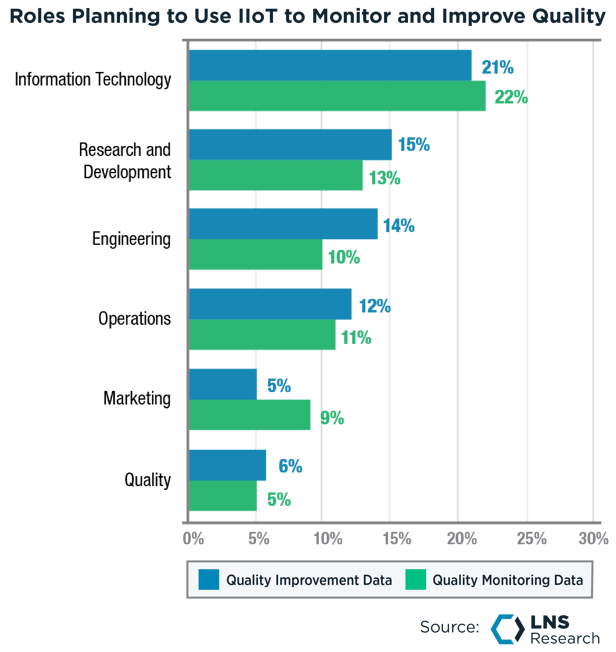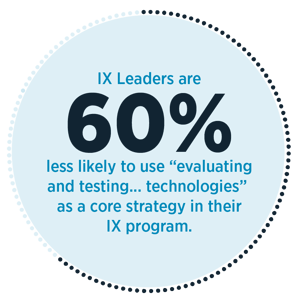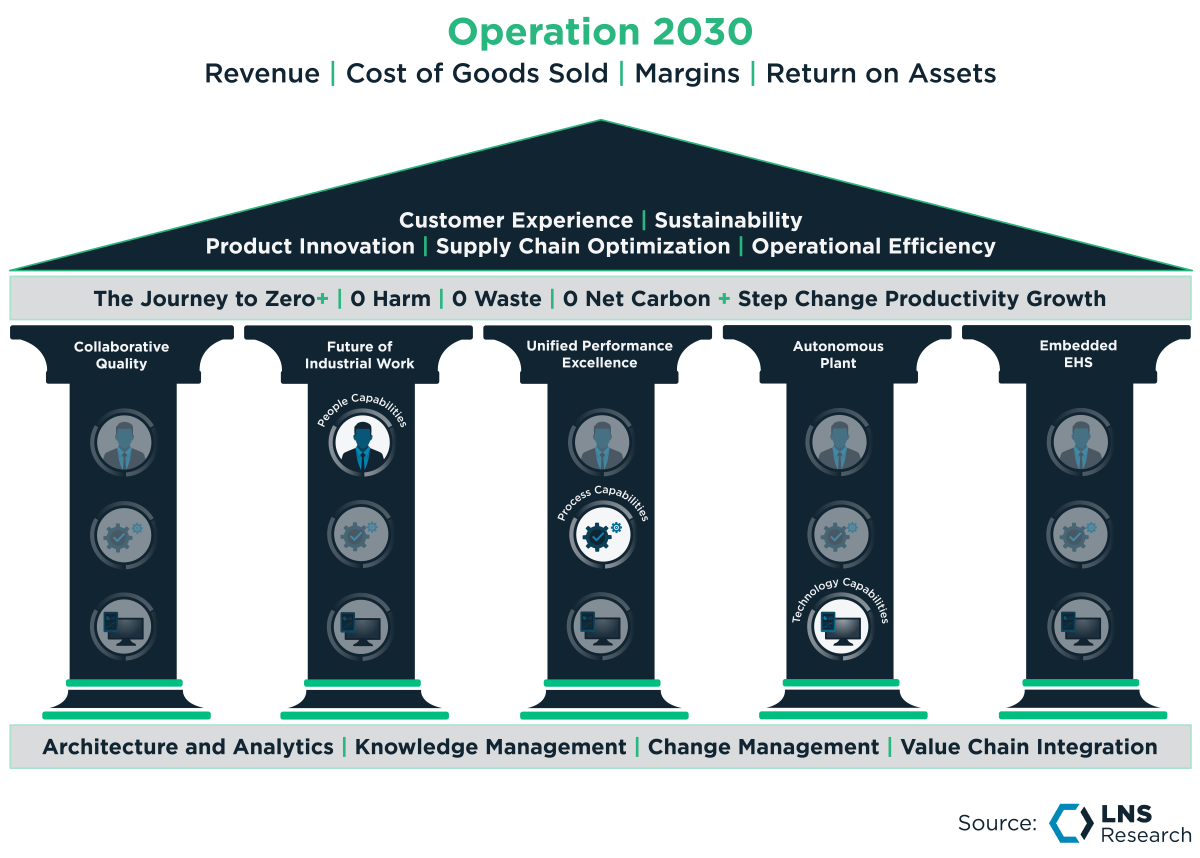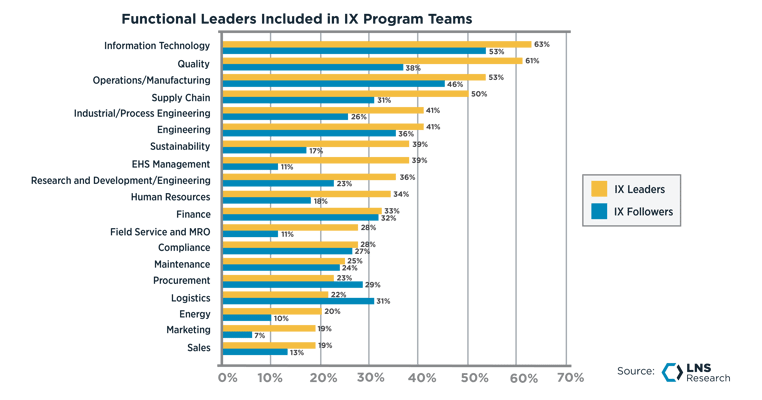Changing Profiles of Industrial Transformation (IX) Leaders
Gain the latest research insights on how transformation programs are evolving, who is taking the lead, and why - including recommendations for IX...
.png?width=272&height=354&name=LNS%20Researchs%20definition%20of%20Industrial%20Transformation%20(IX).png) LNS Research repeatedly hears the request: “Help us convince the plants to adopt our solutions.” The request is a tell-tale sign that the company has the Pivotal P’s (Prepositions, Push, Pull) wrong, which has led to the inefficient organization of its Industrial Transformation (IX) program. Let’s take a closer look at these Pivotal P's, the lessons they highlight, and how to use them to align your IX Program properly.
LNS Research repeatedly hears the request: “Help us convince the plants to adopt our solutions.” The request is a tell-tale sign that the company has the Pivotal P’s (Prepositions, Push, Pull) wrong, which has led to the inefficient organization of its Industrial Transformation (IX) program. Let’s take a closer look at these Pivotal P's, the lessons they highlight, and how to use them to align your IX Program properly.
It may seem trivial in the domain of digital technologies, but LNS Research believes in the Power of Prepositions. The reason is that it highlights one of the most common organizational issues we see in IX, especially those programs that are IT-heavy organizationally. We capture the Power in Prepositions with a simple mantra:
IX should not be something you are doing TO operations and the plants.
IX should not be something you are doing FOR operations and the plants.
IX should be something you are doing WITH operations and the plants
The message must be clear. The IX Program must be a JOINT effort of management, IT, IX, Operations Management, and plant personnel.
Too often, we see technologist-led1 programs focused on technology experimentation, failing to engage operations effectively in the initial stages of the program. One of the clearest examples of this can be seen in IX initiatives to improve Quality: the Quality function is simply not involved in the program’s efforts to improve quality. However, that is only one example. It is quite common to hear the Transformation Team developing a series of “apps” for use by operations personnel. Often, the development was without significant customer/user engagement, even if the team ostensibly used an Agile methodology. These programs regularly stagnate or fail.
Evidence from a Biologics Manufacturer: At an LNS Research The IX Event, the “new” head of transformation presented on their transformation restart. The first program was a corporate-led project, headed by their newly appointed CDO, that created a series of apps from new digital technology. Adoption was problematic, and the program stagnated. The restart was “plant out” with deep engagement from the business, driven by manufacturing goals (automated batch release) and focused on tangible business benefits. The restart was a success and is accelerating across the company.
 Making IX something you are doing TO or FOR operations and the plants is a technology push. LNS Research has consistently found that IX Leaders are 60% less likely to use “evaluating and testing…technologies” as a core strategy in their IX Program and 31% more likely to use business improvement strategies to organize the program. Understanding the power of technology to enable change is important but cannot be the organizing principle of the IX program.
Making IX something you are doing TO or FOR operations and the plants is a technology push. LNS Research has consistently found that IX Leaders are 60% less likely to use “evaluating and testing…technologies” as a core strategy in their IX Program and 31% more likely to use business improvement strategies to organize the program. Understanding the power of technology to enable change is important but cannot be the organizing principle of the IX program.
Push is common and sometimes very subtle. In advising a large Life Sciences manufacturer on their program recently, we noted that their “To Be” vision was inherently a technology push. The goal was described as the “Predictive Plant” with a series of technology benchmarks. Our advice was to establish business improvement benchmarks associated with that “To Be” vision and to use those to determine success. Moving up the analytics capability ladder may be part of the technical solution or even all of the solution, but the goal needs to be better manufacturing and/or quality performance.
Evidence from a Materials Manufacturer: During a customer engagement, the head of worldwide manufacturing changed, triggering a transformation restart. His message was, “I am going to fire any technology personnel that comes in here asking for help getting plants to adopt their solutions. The plants have their goals. They know the answer (the increasingly tough financial improvements they are being challenged to achieve) and know technology is required to get them there. The plants should be driving you on what technologies they need.”
The goal, in other words, is to get “pull” for digital technologies from the plants. One reason this is so critical is the funding model for IX. Over sixty percent of companies expect plants to self-fund 100% of the rollout of IX technologies. Another 20%+ are expecting plants to fund the vast majority of the deployment. This is not the centralized, corporate-funded rollouts of the big ERP deployments over the last couple of decades. Plants have significant demands on their capital, such as new equipment, upgrades to existing systems, other corporate technology initiatives, and new IX initiatives. New digital technologies are just one of many. Plants are, therefore, the ultimate arbiter of IX success.
So, we know why these Pivotal P's matter so much. The question becomes how to get your IX program aligned. There are a series of best practices on how to organize, staff, and lead IX. LNS Research has documented those previously. Let’s drill into the most applicable to our discussion.
Financial/Business, not Technology Goals
We have already telegraphed one of the most essential tactics in an IX Program, organization. The goals of the program, each initiative, and most technology deployments2 should be business-driven targets. Regularly, we hear program goals articulated as a progression up the analytics capability staircase: Descriptive, Diagnostic, Predictive, Prescriptive, and even Prognostic. Important conceptually but fundamentally a technology push. High-level targets such as a data-driven organization, smart manufacturing, or intelligent plants are common but still fundamentally technology-oriented.
Goals like being the lowest cost manufacturer in our market, improving customer responsiveness (on time in full would be one of the specific metrics of that), improving labor productivity by X%, and improving yield by Y% are all manufacturing-related targets that can drive technology adoption. In most companies, the only way to achieve those targets – if they are “step change” targets – is to deploy new technology. These goals should tie into improving both manufacturing metrics and, more importantly, financial performance. The goals should be quite specific and tracked carefully.
Organizing around business improvement goals has two symbiotic advantages. First, it ensures the priority of business over technology. Second, it drives technologists to engage operations and plant personnel to understand their objectives and operational challenges.
Beyond specific numerical goals, LNS Research would also encourage industrials to adopt business-oriented “vision stories” to paint the “To Be” environment for the enterprise. IX Leaders consistently articulate a “vision story” of what digital operations will eventually look like. Core to the vision are aspirational concepts. IX Leaders are typically building their Vision Story around one or more of the following concepts:
Getting closer to the customer
Building more agile and/or resilient operations (particularly given supply chain and demand disruptions)
Accelerating innovation
Increasing collaboration internally and with suppliers and customers

These concepts are about the business, not technology. And they are integrating their Vision Story into and aligned with overall corporate strategy.
Deep Engagement with Plant and Operations Personnel
It is a simple concept: invite them to the party. IX Leaders – the 20% of companies realizing meaningful results from their IX program – are significantly more inclusive in staffing. IX Leaders want representation and participation from everywhere. The data is overwhelming on the value of inclusiveness of the IX Program. IX Leaders are:
More inclusive with 17 out of 19 different business functions.
TWICE as likely as Laggards to be seen as reaching “across” and “deep” into the company for subject matter expertise (SME)
FIVE times more likely to include operations – not just OT – as part of the Industrial Transformation team.

The trend is so pronounced that we have highlighted it as one of the 7 IX Best Practices: “Morph to Bottom-Up (Engage Business/Operations).”
This focus on inclusion is not for the sake of inclusion. It is about bringing domain expertise into the IX program. Operations personnel know their problems and often have hypotheses for solutions. Quality, Engineering, Field Service, and other functional teams have very specialized skills and roles to play within the value chain. It is much more complex than it seems to create meaningful “apps” for these highly specialized roles without deep domain expertise. Engaging operations personnel as early as possible in the program is ideal. Integrating them into the conference room pilot activity can improve the impact of even technological exploration.
Bring Along the Whole Manufacturing Network
As you think about your inclusion strategy, be sure to reach widely across operations and different types of manufacturing plants. It is quite common for programs to focus on their “Lighthouse” plants, their best and most technically advanced plants, to make them even better. Engaging personnel in those plants is necessary but woefully insufficient. Research shows:
Lighthouse Strategies are effective only in the beginning stages of IX.
Solutions developed for lighthouse plants seldom can be readily deployed in less advanced plants (and therefore lead to technology “pushes”)
Technical skills and willingness to engage in technology are often quite different in lighthouse plants than in “the rest of the fleet.”
Therefore, building a “super user” or “digital ambassador” network across your operations should be an essential activity even in the early stages of IX. Especially important is to ensure you have “digital ambassadors” representing all segments of your manufacturing network, from the most automated to the least automated plants.
 One of the key reasons this is so important is that you may find that the key transformational opportunity for large swatches of your manufacturing base is not in deploying new, sexy digital technologies like Artificial Intelligence (AI) or Advanced Industrial Analytics but instead upgrading/rearchitecting legacy OT and IT solutions. It is hard to apply AI to paper-based manufacturing, and on average, less than 43% of plant equipment is connected today. IX Leaders are TWICE as likely to be upgrading/rearchitecting both IT and OT. This is not what most companies think of when they think of Digital Transformation. Most think about new business models enabled by cutting-edge technology. But by forcing yourself to look at the whole manufacturing network, you will avoid later trying to push flashy technology onto plants that simply cannot leverage it.
One of the key reasons this is so important is that you may find that the key transformational opportunity for large swatches of your manufacturing base is not in deploying new, sexy digital technologies like Artificial Intelligence (AI) or Advanced Industrial Analytics but instead upgrading/rearchitecting legacy OT and IT solutions. It is hard to apply AI to paper-based manufacturing, and on average, less than 43% of plant equipment is connected today. IX Leaders are TWICE as likely to be upgrading/rearchitecting both IT and OT. This is not what most companies think of when they think of Digital Transformation. Most think about new business models enabled by cutting-edge technology. But by forcing yourself to look at the whole manufacturing network, you will avoid later trying to push flashy technology onto plants that simply cannot leverage it.
Industrial Transformation (IX) is simply a collaboration between technology and business. The sad reality is that it is not easy to foster that collaboration. Technologists have their priority. Business and Operations have theirs. Executives need to align those objectives, teams, and the Pivotal P's.
1 We use the phrase “technologists” to cover technical personnel in an IT, IX, or corporate OT organization.
2 We use the word “most” deliberately around technology deployments. In a recent blog post, Is a 2-Step Dance the Key to Transformation Success, we noted that some technology projects need to be executed without specific ROI goals.
As a member-level partner of LNS Research, you will receive our expert and proven Advisory Services. These exclusive benefits give your team:
Let us help you with key decisions based on our solid research methodology and vast industrial experience.
BOOK A STRATEGY CALLSiemens Acquires Camstar: Better Realizing Innovation for 3 Vertical Industries
Five Ways Industrial AI is Shaking Up Manufacturing (and Who’s Doing It)
The Definitive Guide to Manufacturing Acronyms
What Is Industrial DataOps & Why Does Every Manufacturer Need It?
Software-Defined Automation: Surprise... It's Not About Cost Savings
Gain the latest research insights on how transformation programs are evolving, who is taking the lead, and why - including recommendations for IX...
Industrial transformation (IX) programs are not one-size-fits-all. This blog post highlights how companies in different regulated industries approach...
ABB is a leader among industrial companies for their Industrial Transformation program. Its approach to IX mirrors the best practices findings from...
The Industrial Transformation and Operational Excellence Blog is an informal environment for our analysts to share thoughts and insights on a range of technology and business topics.